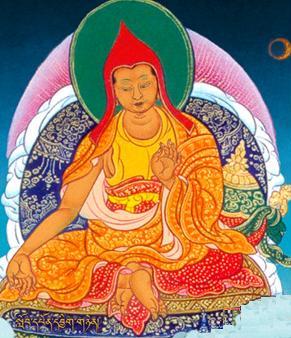Vasubandhu: Difference between revisions
No edit summary |
|||
| Line 16: | Line 16: | ||
Other texts include: | Other texts include: | ||
* | *A commentary on the ''[Sutra of the Ten Bhumis]]'' | ||
*A commentary on the ''[[Sutra Teaching the Beginnings and the Divisions of Dependent Arising]]'' (Skt. ''Pratītyasamutpādādi-vibhaṅga-nirdeśa'') | |||
*A commentary on the [[ | |||
*Gāthāsaṃgrahaśāstra-nāma (Wyl. ''bstan bcos tshigs su bcad pa bsdus pa zhes bya ba'') | *Gāthāsaṃgrahaśāstra-nāma (Wyl. ''bstan bcos tshigs su bcad pa bsdus pa zhes bya ba'') | ||
*Gāthāsaṃgrahaśāstrārtha-nāma (Wyl. ''tshigs su bcad pa'i don bsdus pa zhes bya ba'i bstan bcos'') | *Gāthāsaṃgrahaśāstrārtha-nāma (Wyl. ''tshigs su bcad pa'i don bsdus pa zhes bya ba'i bstan bcos'') | ||
*Ekagāthābhāṣya (Wyl. ''tshigs su bcad pa gcig pa'i bshad pa'') | *Ekagāthābhāṣya (Wyl. ''tshigs su bcad pa gcig pa'i bshad pa'') | ||
*''Sukhāvatīvyūhopadeśa'' (Skt.), a treatise on the ''[[Amitayurdhyana Sutra]]'' | |||
*''[[Treatise on the Three Natures]]'' | |||
==His Disciples== | ==His Disciples== | ||
Revision as of 20:09, 30 January 2021

Vasubandhu (Skt.; Tib. དབྱིག་གཉེན་, Yiknyen, Wyl. dbyig gnyen) (ca. 316-396)[1] numbers among the ‘Six Ornaments’, the greatest Buddhist authorities of Ancient India. He was born in Purusapura, present-day Peshawar, Pakistan, in what was then the Kingdom of Gandhara, and was the younger half-brother of Asanga. He composed the Treasury of Abhidharma, a complete and systematic account of the Abhidharma, the peak of scholarship in the Fundamental Vehicle. Later he followed the Mahayana Yogachara view, and wrote many works, such as Thirty Stanzas on the Mind.
His Writings
Vasubandhu was a prolific author and wrote texts on a wide variety of subjects, his most famous work being the Abhidharmakosha.
A set of eight texts are referred to as the Eight Treatises (the Eight Prakarana):
- A commentary on The Ornament of the Mahayana Sutras
- A commentary on Distinguishing the Middle from Extremes
- A commentary on Distinguishing Dharma and Dharmata
- Well Explained Reasoning
- Treatise on Karma
- Analysis of the Five Skandhas
- Twenty Stanzas
- Thirty Stanzas
Other texts include:
- A commentary on the [Sutra of the Ten Bhumis]]
- A commentary on the Sutra Teaching the Beginnings and the Divisions of Dependent Arising (Skt. Pratītyasamutpādādi-vibhaṅga-nirdeśa)
- Gāthāsaṃgrahaśāstra-nāma (Wyl. bstan bcos tshigs su bcad pa bsdus pa zhes bya ba)
- Gāthāsaṃgrahaśāstrārtha-nāma (Wyl. tshigs su bcad pa'i don bsdus pa zhes bya ba'i bstan bcos)
- Ekagāthābhāṣya (Wyl. tshigs su bcad pa gcig pa'i bshad pa)
- Sukhāvatīvyūhopadeśa (Skt.), a treatise on the Amitayurdhyana Sutra
- Treatise on the Three Natures
His Disciples
He famously had four students who were more learned than himself:
- Sthiramati, who was more learned in Abhidharma;
- Dignāga, who was more learned in Pramāṇa;
- Guṇaprabha, who was more learned in the Vinaya; and
- Arya Vimuktasena, who was more learned in Prajñāpāramitā.
These students are not necessarily considered to be his direct students, but perhaps more in the sense that they followed in his lineage.
References
- ↑ According to S. Anacker's estimation. According to others such as Thomas Lee Dowling, Vasubandhu would have lived more towards the beginning of the 5th cent.
Further Reading
- Stefan Anacker, Seven Works of Vasubandhu: The Buddhist Psychological Doctor (Delhi: Motilal Banarsidass, 1984; 2nd Edition, 2002), 'II. Vasubandhu, His Life and Times'
- Philippe Cornu, Vasubandhu, Cinq traités sur l'esprit seulement (Paris: Fayard, 2008), 'Introduction'
- Thomas Lee Dowling, Vasubandhu on the Avijñapti-rūpa: a study in fifth-century Abhidharma Buddhism, Ph.D., 1976., Columbia University, p. 23-39
- Erich Frauwallner, On the Date of the Buddhist Master of the Law Vasubandhu (Rome: IsMeo, 1951)
- E. Lamotte, Karmasiddhiprakarana: le traité de l'acte de Vasubandhu, Bruxelles 1936
- Karmasiddhi Prakarana: The Treatise on Action by Vasubandhu, English translation by Leo M. Pruden
- J. Takakusu, The Life of Vasubandhu by Paramārtha, T'oung Pao (1904)
- Lobsang N. Tsonawa, Indian Buddhist Pandits from The Jewel Garland of Buddhist History (Dharamsala: Library of Tibetan Works and Archives, 1985)